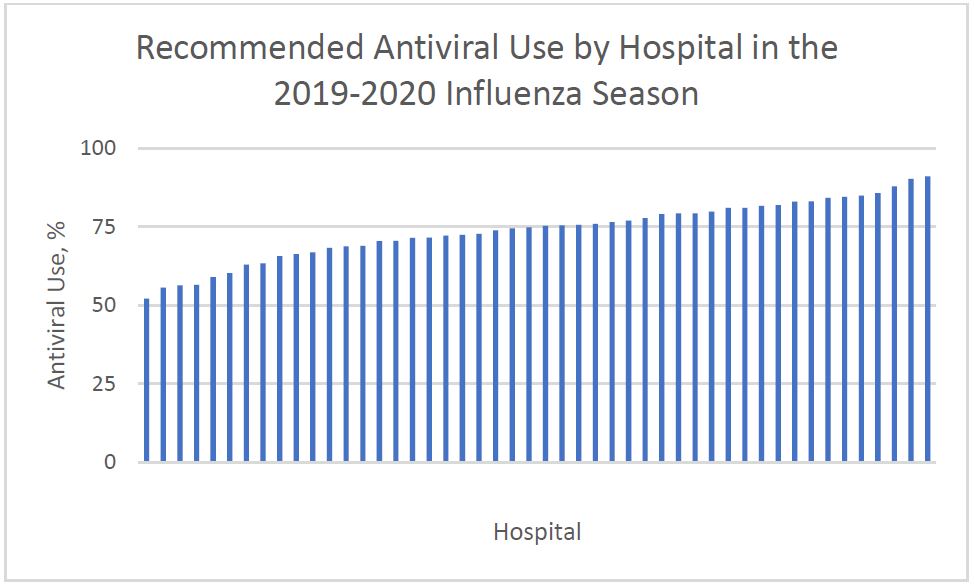Back
Infectious Diseases
Category: Abstract Submission
Infectious Diseases: Respiratory Viruses
587 - Use of recommended antiviral agents in pediatric patients hospitalized with influenza
Monday, April 25, 2022
3:30 PM – 6:00 PM US MT
Poster Number: 587
Publication Number: 587.417
Publication Number: 587.417
Kavita S. Warrier, University of Michigan Medical School, Ann Arbor, MI, United States; Alison Tribble, C.S. Mott Children's Hospital, Ann Arbor, MI, United States
- KW
Kavita S. Warrier, MD, MS
Fellow, Pediatric Infectious Diseases
University of Michigan Medical School
Ann Arbor, Michigan, United States
Presenting Author(s)
Background: Antiviral medications improve outcomes and reduce hospitalization length in children with influenza, and CDC/AAP recommend their use for children hospitalized with influenza since the 2009-2010 pandemic season. Five years after the pandemic, antiviral use at children’s hospitals rose to only 73%, leaving a sizable proportion of children, including those at high risk for severe illness, without antiviral therapy. What factors drive antiviral use, and if uptake has improved, are unknown.
Objective: We sought to describe current antiviral use for children hospitalized with influenza, identify patient characteristics associated with receipt of recommended antivirals, and assess trends in use and variability by hospital.
Design/Methods: Using Pediatric Health Information System data, we conducted a retrospective analysis of children 0-17 years with ICD-9/10 codes of influenza discharged from children’s hospitals between 10/2010 and 6/2020. We excluded those with influenza discharges in the prior 30 days or stay < 1 day. Receipt of antivirals was modeled using mixed effects logistic regression to account for hospital clustering and adjust for risk factors for severe influenza illness, illness severity (need for vasopressors, mechanical ventilation, or ECMO) and influenza season. We used descriptive statistics and X2 to assess receipt of recommended antivirals over time and by hospital for the 2019-20 influenza season.
Results: We identified 83034 influenza discharges (56% male; median age 3 years [IQR 1-8 years]) at 49 hospitals. 11% had severe illness, 72% had ≥1 risk factor, and 71% received recommended antivirals. Receipt of recommended antivirals was associated with influenza risk factors (OR 1.3 [CI 1.2-1.5]) and severe illness (OR 1.4 [CI 1.3-1.5]) (Fig 1). Overall antiviral use was unchanged over the past 5 years (2019 vs 2014: OR 1.029[CI 0.8-1.3]). Although use for severe disease was highest in 2019 (87%), receipt among low-risk patients declined (62%) [X2 p< 0.001]. The proportion of antiviral receipt by hospital ranged from 0.52 (SE 0.02) to 0.90 (SE 0.02) (Fig 2); only 27% of hospitals provided antivirals to >80% of patients.Conclusion(s): Despite longstanding national recommendation for antiviral use in children hospitalized with influenza, a substantial proportion do not receive antiviral therapy, including 30% in the 2019-2020 influenza season. Overall use has remained static, with declining use in low-risk children. Antiviral use also varies considerably across pediatric hospitals. To provide optimal care for children hospitalized with influenza, children’s hospitals should address these gaps.
CVKW.pdf
Recommended Antiviral Use by Hospital in the 2019-2020 Influenza Season Use of recommended antiviral medications for children hospitalized with influenza varies by hospital, ranging from 52% to 91%.
Use of recommended antiviral medications for children hospitalized with influenza varies by hospital, ranging from 52% to 91%.
Objective: We sought to describe current antiviral use for children hospitalized with influenza, identify patient characteristics associated with receipt of recommended antivirals, and assess trends in use and variability by hospital.
Design/Methods: Using Pediatric Health Information System data, we conducted a retrospective analysis of children 0-17 years with ICD-9/10 codes of influenza discharged from children’s hospitals between 10/2010 and 6/2020. We excluded those with influenza discharges in the prior 30 days or stay < 1 day. Receipt of antivirals was modeled using mixed effects logistic regression to account for hospital clustering and adjust for risk factors for severe influenza illness, illness severity (need for vasopressors, mechanical ventilation, or ECMO) and influenza season. We used descriptive statistics and X2 to assess receipt of recommended antivirals over time and by hospital for the 2019-20 influenza season.
Results: We identified 83034 influenza discharges (56% male; median age 3 years [IQR 1-8 years]) at 49 hospitals. 11% had severe illness, 72% had ≥1 risk factor, and 71% received recommended antivirals. Receipt of recommended antivirals was associated with influenza risk factors (OR 1.3 [CI 1.2-1.5]) and severe illness (OR 1.4 [CI 1.3-1.5]) (Fig 1). Overall antiviral use was unchanged over the past 5 years (2019 vs 2014: OR 1.029[CI 0.8-1.3]). Although use for severe disease was highest in 2019 (87%), receipt among low-risk patients declined (62%) [X2 p< 0.001]. The proportion of antiviral receipt by hospital ranged from 0.52 (SE 0.02) to 0.90 (SE 0.02) (Fig 2); only 27% of hospitals provided antivirals to >80% of patients.Conclusion(s): Despite longstanding national recommendation for antiviral use in children hospitalized with influenza, a substantial proportion do not receive antiviral therapy, including 30% in the 2019-2020 influenza season. Overall use has remained static, with declining use in low-risk children. Antiviral use also varies considerably across pediatric hospitals. To provide optimal care for children hospitalized with influenza, children’s hospitals should address these gaps.
CVKW.pdf
Recommended Antiviral Use by Hospital in the 2019-2020 Influenza Season
 Use of recommended antiviral medications for children hospitalized with influenza varies by hospital, ranging from 52% to 91%.
Use of recommended antiviral medications for children hospitalized with influenza varies by hospital, ranging from 52% to 91%.